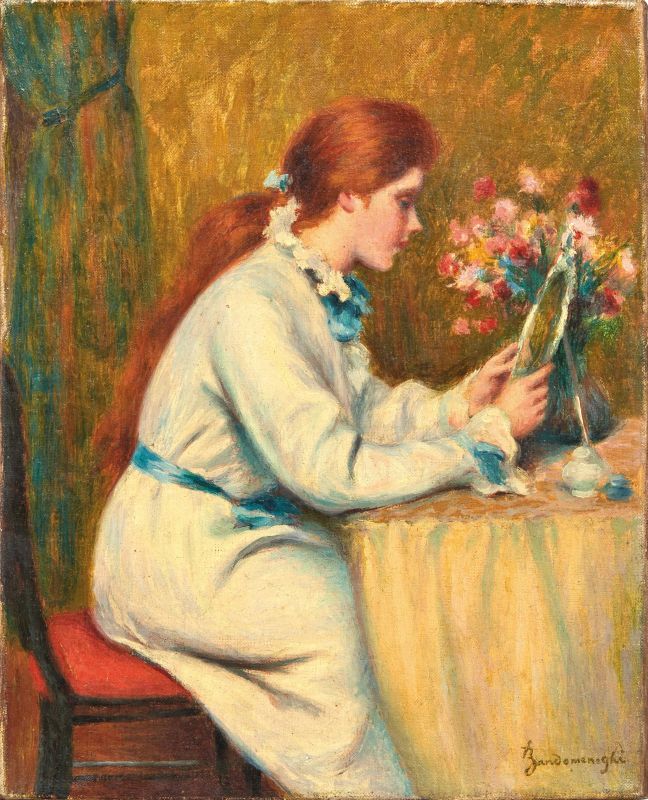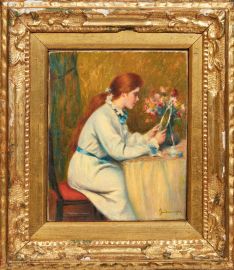Federico Zandomeneghi (Venezia, 1841 - Paris, 1917)
Federico Zandomeneghi
Federico Zandomeneghi
(Venezia 1841 - Paris 1917)
LA TOILETTE
1897 circa
firmato in basso a destra
olio su tela
cm 27,2x22,2
sul retro: timbri della Collezione Lorenzo Pellerano di Buenos Aires, etichetta della Venta de la Galeria de Cuadros de D. Lorenzo Pellerano, etichetta di collezione sul telaio
LA TOILETTE
circa 1897
signed lower right
oil on canvas
10 ¾ by 8 13/16 in
on the reverse: stamps of the Lorenzo Pellerano Collection, Buenos Aires, label of the Venta de la Galeria de Cuadros de D. Lorenzo Pellerano, collection label on the stretcher
Provenienza
Paris, collezione Durand-Ruel
Buenos Aires, collezione Lorenzo Pellerano
Guerrico & Williams, Buenos Aires, Venta de la
Galeria de Cuadros de D. Lorenzo Pellerano, ottobre 1933
Bibliografia
Coleccion Pellerano. La Galeria de cuadros de Lorenzo Pellerano, catalogo della vendita a cura della casa d'aste Guerrico e Williams, Buenos Aires 1933, n. 993, p. 128.
E. Piceni, Zandomeneghi, Milano 1967, n. 420.
F. Dini, Federico Zandomeneghi, la vita e le opere, Firenze 1989, p. 434, n. 150, tav. CXLV.
E. Piceni, Zandomeneghi, Busto Arsizio 1991, n. 420.
C. Testi, M.G. Piceni, E. Piceni, Federico Zandomeneghi. Catalogo generale. Nuova edizione aggiornata ed ampliata, Milano 2006, p. 292, n. 415.
Il soggetto femminile colto nell’intimità delle mura domestiche è sicuramente uno dei temi prediletti da Zandomeneghi, diverse sono le testimonianze di donne che, ancora nude, in vestaglia o vestite solo in parte, si dedicano alla toilette, controllando allo specchio il trucco e la piega dei capelli. In questo dipinto realizzato a fine Ottocento con quella pennellata morbida dalle calde e rassicuranti cromie amate dal pittore, Zandomeneghi raffigura una giovane seduta al tavolo che porta a se uno specchio d’appoggio. Il gioco della propria immagine riflessa ha da sempre un fascino particolare, la protagonista osserva i tratti del suo volto quasi voglia accertarsi di essere in ordine agli occhi di chi la ritrae. L’ambiente è arricchito da una natura morta floreale collocata sul tavolo. Il quadro, di proprietà Durand-Ruel, è poi passato nella celebre raccolta di Lorenzo Pellerano è andato in asta a Buenos Aires nel 1933, con il titolo Chica ante el espejo, due anni dopo la scomparsa del suo proprietario. All’epoca della vendita all’incanto, la collezione Pellerano annoverava 1300 opere dei pittori europei maggiormente noti tra il XV e il XIX secolo acquisiti nel corso di un ampio periodo di tempo grazie al fiorente mercato collezionistico argentino intrapreso dall’argentino Manuel Jose de Guerrico, esule a Parigi tra il 1838 e il 1848, incrementato in seguito dal gallerista italiano Ferruccio Stefani. Secondo Francesca Dini (p. 434, n. 150) l’opera è affine a Femme à l’ombrelle della collezione Jucker e ad altre opere caratterizzate da un brillante e vibrante cromatismo.
Women captured in the intimacy of their homes were certainly among Zandomeneghi’s favourite subjects. There are many paintings of women nude, in dressing gowns, or partly dressed at the toilette, checking their hairdos and appearance in the mirror. In this picture, painted at the end of the nineteenth century with the soft brushstrokes and warm, reassuring colours he loved, Zandomeneghi portrayed a young woman seated at a table and holding a mirror. Images reflected in mirrors always hold a particular charm, the sitter is looking at herself almost as if she wants to make sure that she is neat and tidy for the artist. The setting is embellished with a vase of flowers on the table. The painting, first owned by Durand-Ruel, went to the famous collection of Lorenzo Pellerano and in 1933, two years after his death, was sold at auction in Buenos Aires with the title Chica ante el espejo. At the time of the sale, there were 1300 works by Europe's best-known fifteenth- to nineteenth-century artists in the Pellerano collection. They were acquired over a considerable period of time thanks to the flourishing Argentine market, fuelled by Manuel José de Guerrico who lived in Paris as an exile from 1838 to 1848, and then augmented by the Italian gallery owner Ferruccio Stefani. According to Francesca Dini (p. 434, n. 150) this painting is similar to Femme à l'ombrelle in the Jucker Collection and other works characterized by bright and vibrant colours.






